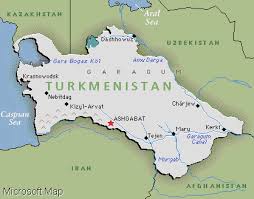Friday, April 24, 2009
 US urges Central Asia to boost gas export routes
US urges Central Asia to boost gas export routes
 04–24–2009 – (AP by Alexander Vershinin) – ASHGABAT, Turkmenistan — A recent crippling gas pipeline blast in Turkmenistan, which the government blamed on Russia's gas monopoly Gazprom, is proof that energy-rich Central Asian nations need to diversify their export routes, a senior U.S. diplomat said Friday. Russia currently controls most natural gas export routes out of the region, but that grip is coming under growing pressure from China and the West. "This explosion or accident with the pipeline makes the argument for the diversification of routes," George Krol, the U.S. deputy assistant secretary for South and Central Asian affairs, said at an international conference on energy transit security in Turkmenistan. Relations between Turkmenistan and Russia have soured over the past two weeks, with Turkmenistan accusing Gazprom of causing the April 8 pipeline blast on its border with Uzbekistan that shut off the Central Asian country's gas exports. Russian Foreign Minister Sergey Lavrov said the incident was "purely technical." The dispute threatens to further delay the start to construction work on a 1,100-mile (1,700-kilometer) pipeline along the Caspian Sea shore that would run from Turkmenistan through Kazakhstan and into Russia's network of pipelines to Europe. Krol denied the charge that U.S. backing for the diversification of export routes from Central Asia is part of a design aimed at undermining Russia. Europe and the United States are lobbying to build an energy route across the Caspian Sea to Central Asia that would bypass Russia. Gas transported via this route would then supply the EU-backed 2,050-mile (3,300 kilometer) Nabucco pipeline that cuts across Azerbaijan, Turkey and the Balkans to Central Europe. China also is close to completing a gas pipeline through Kazakhstan and Uzbekistan that will allow for annual natural gas exports of 1,059 billion cubic feet (30 billion cubic meters) within the next two years. Krol also said the U.S. government remains open to the prospect of Central Asian gas being exported to the West through Iran, which borders Turkmenistan to the south. Speaking about opportunities for U.S. energy companies in Turkmenistan, Krol said recently adopted legislation was making life easier for foreign investors. "But we have to see how the law is applied. That will take time" he said. He said Chevron Corp. has opened a representative office in Turkmenistan and is currently engaged in negotiations with government officials. International competition over access to Turkmenistan's vast oil and gas resources intensified following the death in 2007 of the country's long-ruling autocrat, Saparmurat Niyazov, who had blocked foreign access to the country's energy sector. Turkmenistan has the second-biggest gas reserves among all ex-Soviet republics after Russia, and its resources are playing an increasingly important role in regional geopolitics.
04–24–2009 – (AP by Alexander Vershinin) – ASHGABAT, Turkmenistan — A recent crippling gas pipeline blast in Turkmenistan, which the government blamed on Russia's gas monopoly Gazprom, is proof that energy-rich Central Asian nations need to diversify their export routes, a senior U.S. diplomat said Friday. Russia currently controls most natural gas export routes out of the region, but that grip is coming under growing pressure from China and the West. "This explosion or accident with the pipeline makes the argument for the diversification of routes," George Krol, the U.S. deputy assistant secretary for South and Central Asian affairs, said at an international conference on energy transit security in Turkmenistan. Relations between Turkmenistan and Russia have soured over the past two weeks, with Turkmenistan accusing Gazprom of causing the April 8 pipeline blast on its border with Uzbekistan that shut off the Central Asian country's gas exports. Russian Foreign Minister Sergey Lavrov said the incident was "purely technical." The dispute threatens to further delay the start to construction work on a 1,100-mile (1,700-kilometer) pipeline along the Caspian Sea shore that would run from Turkmenistan through Kazakhstan and into Russia's network of pipelines to Europe. Krol denied the charge that U.S. backing for the diversification of export routes from Central Asia is part of a design aimed at undermining Russia. Europe and the United States are lobbying to build an energy route across the Caspian Sea to Central Asia that would bypass Russia. Gas transported via this route would then supply the EU-backed 2,050-mile (3,300 kilometer) Nabucco pipeline that cuts across Azerbaijan, Turkey and the Balkans to Central Europe. China also is close to completing a gas pipeline through Kazakhstan and Uzbekistan that will allow for annual natural gas exports of 1,059 billion cubic feet (30 billion cubic meters) within the next two years. Krol also said the U.S. government remains open to the prospect of Central Asian gas being exported to the West through Iran, which borders Turkmenistan to the south. Speaking about opportunities for U.S. energy companies in Turkmenistan, Krol said recently adopted legislation was making life easier for foreign investors. "But we have to see how the law is applied. That will take time" he said. He said Chevron Corp. has opened a representative office in Turkmenistan and is currently engaged in negotiations with government officials. International competition over access to Turkmenistan's vast oil and gas resources intensified following the death in 2007 of the country's long-ruling autocrat, Saparmurat Niyazov, who had blocked foreign access to the country's energy sector. Turkmenistan has the second-biggest gas reserves among all ex-Soviet republics after Russia, and its resources are playing an increasingly important role in regional geopolitics.
Contact me:


